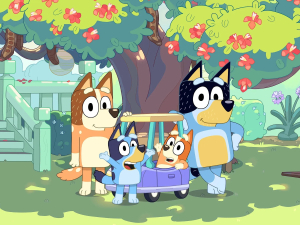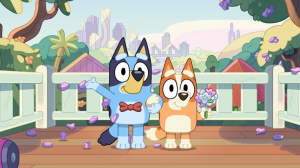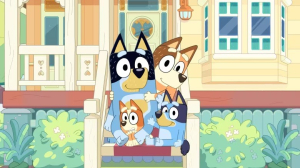
The Charm of an Australian Blue Heeler Welcome to the world of Bluey, where life's simplest moments transform into adventures of colossal proportions. This animated series from Down Under centered around a lovable Australian Blue Heeler named Bluey and her family, has captivated viewers with its blend of humor, heart, and valuable life lesso...



Bluey
The Charm of an Australian Blue Heeler
Welcome to the world of Bluey, where life's simplest moments transform into adventures of colossal proportions. This animated series from Down Under centered around a lovable Australian Blue Heeler named Bluey and her family, has captivated viewers with its blend of humor, heart, and valuable life lessons. But what exactly makes this show an international phenomenon captivating both young audiences and adults alike? This review takes a plunge into the colorful world of Bluey, Bingo, Bandit, and Chilli to unearth the magic that has propelled this show into the hearts of millions around the globe.
Unpacking the Family Dynamic and the Bandit Conundrum
At its core, Bluey is a series about family life and the wonders of childhood imagination. Following Bluey and her sister Bingo, each episode offers a tapestry of play that encourages kids to learn while also providing parents and caregivers with a mirror to their world — reflecting the joys and challenges that come with raising children.
Notably, Bluey's father, Bandit, is a character that generates as much discussion as the show itself. Bandit's unwavering dedication to engaging in his daughters' games and his consistently positive parenting style set a high benchmark. However, some viewers have pointed out that Bandit's near-perfect paternal portrayal may set unrealistic expectations for parents. His exceptional parenting style, while admirable, might inadvertently project pressure on viewers who relate more to the mundane trials of family life and the balancing act between work, parenting, and personal space.
Moreover, while the show succeeds in many ways, it hasn't entirely escaped critique. Some of its initial feedback highlighted a lack of diversity among its characters, and though the show has taken strides to address these concerns, it remains a topic of conversation. Nonetheless, such critiques have not detracted from the show's popularity, as its creators have shown a willingness to evolve and improve the inclusivity of Bluey's world.
A New Benchmark in Children's Entertainment
Since its debut, Bluey has struck a resonant chord with audiences, rapidly accruing a global fanbase. Fans laud the show for more than its endearing characters and compelling storylines; it's the nuanced depiction of family life and parental love that leaves the most profound impression. Bandit's inspiring parenting, coupled with Chilli's compassionate demeanor, presents a family dynamic that, despite criticisms, has been predominantly received with open arms.
What some may see as weaknesses, others perceive as opportunities for the show to connect and grow with its audience. The discussions around its representation and parenting portrayals contribute to a broader conversation on family and media. As viewers eagerly anticipate the release of new episodes and content, the consensus is clear: Bluey has achieved something special. By mixing astute observations of family life with the fearless creativity of children's play, Bluey sets a new benchmark for what children's programming can be — not just entertaining but enriching and educational in the most delightful way.
In conclusion, as the wait for the third season continues, the discussions and communal bonds formed around Bluey's adventures underscore the show's impact. It's not just a children’s program; it's a phenomenon that transcends generations, bringing families together to collectively embrace their inner child.


